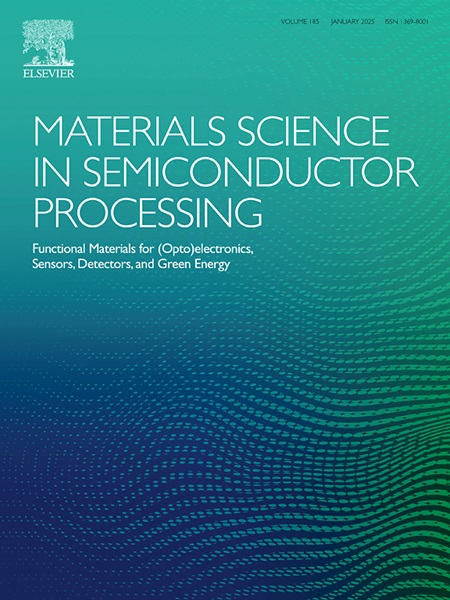CuPt nano-alloy as bifunctional electrocatalyst for N2H4 oxidation-assisted H2 generation and multifunctional sensor materials
IF 4.2
3区 工程技术
Q2 ENGINEERING, ELECTRICAL & ELECTRONIC
引用次数: 0
Abstract
This work combined lattice strain effect and surfactant-free interface of CuPt nanoalloy to achieve the low-potential catalytic H2 Evolution Reaction (HER) and Hydrazine Oxidation Reaction (HzOR). Compared to the electro-catalysis of oxygen evolution reaction, the CuPt nano-alloy exhibited a lower potential in the electro-catalysis of HzOR. The voltage required for N2H4 oxidation-assisted H2 generation by surfactant-free Cu83Pt17 nano-alloy was 0.28 V (at 10 mA/cm2), which was only 14.97 % of that needed for H2O splitting (1.87 V at 10 mA/cm2). Moreover, the ligand-free surface maximized the interfacial contact area of CuPt nanoalloy with reactants, thereby enhancing both its stability and electrocatalytic activity in both the cathode and anode reactions. As compared with the CuPt nano-alloy synthesized by using a surfactant (Un-CuPt), the surfactant-free Cu83Pt17 nano-alloy in this work could achieve a 39.1 % reduction in the working voltage for N2H4 splitting. When the output current density reaches 100 mA/cm2, the corresponding working potential for HzOR was 435.31 mV vs RHE. After a 72-h for HzOR, the anode potential (at 10 mA/cm2) for the surfactant-free Cu83Pt17 nano-alloy increased by only 3.97 % (158.8 mV–165.1 mV), indicating its promising stability. As a multifunctional electrocatalyst, the CuPt nano-alloy demonstrated a promising performance in the construction of H2O2 and NaNO2 sensors. This work successfully introduced a bifunctional electrocatalyst for N2H4 oxidation-assisted H2 generation, addressing the inferior catalytic activity of commercial Pt/C in HzOR and its inadequate stability. Considering the relatively low cost of Cu, the obtianed results would pave a promising research avenue for designing highly efficient electrocatalysts for H2 generation or constructing sensors.
CuPt纳米合金作为N2H4氧化辅助H2生成的双功能电催化剂和多功能传感器材料
结合CuPt纳米合金的晶格应变效应和无表面活性剂界面,实现了低电位催化析氢反应(HER)和肼氧化反应(HzOR)。与析氧反应的电催化相比,CuPt纳米合金在HzOR的电催化中表现出较低的电位。无表面活性剂Cu83Pt17纳米合金在N2H4氧化辅助下生成H2所需电压为0.28 V (10 mA/cm2),仅为水裂解所需电压(1.87 V, 10 mA/cm2)的14.97%。此外,无配体表面使CuPt纳米合金与反应物的界面接触面积最大化,从而提高了其在阴极和阳极反应中的稳定性和电催化活性。与使用表面活性剂(Un-CuPt)合成的CuPt纳米合金相比,无表面活性剂的Cu83Pt17纳米合金可使N2H4劈裂工作电压降低39.1%。当输出电流密度达到100 mA/cm2时,HzOR对应的工作电位为435.31 mV vs RHE。在HzOR作用72 h后,无表面活性剂Cu83Pt17纳米合金的阳极电位(10 mA/cm2)仅增加了3.97% (158.8 mV - 165.1 mV),表明其具有良好的稳定性。CuPt纳米合金作为一种多功能电催化剂,在构建H2O2和NaNO2传感器方面表现出了良好的性能。本工作成功地引入了一种N2H4氧化辅助制氢的双功能电催化剂,解决了商用Pt/C在HzOR中催化活性差和稳定性不高的问题。考虑到Cu的成本相对较低,所获得的结果将为设计高效的制氢电催化剂或构建传感器铺平一条有前途的研究道路。
本文章由计算机程序翻译,如有差异,请以英文原文为准。
求助全文
约1分钟内获得全文
求助全文
来源期刊

Materials Science in Semiconductor Processing
工程技术-材料科学:综合
CiteScore
8.00
自引率
4.90%
发文量
780
审稿时长
42 days
期刊介绍:
Materials Science in Semiconductor Processing provides a unique forum for the discussion of novel processing, applications and theoretical studies of functional materials and devices for (opto)electronics, sensors, detectors, biotechnology and green energy.
Each issue will aim to provide a snapshot of current insights, new achievements, breakthroughs and future trends in such diverse fields as microelectronics, energy conversion and storage, communications, biotechnology, (photo)catalysis, nano- and thin-film technology, hybrid and composite materials, chemical processing, vapor-phase deposition, device fabrication, and modelling, which are the backbone of advanced semiconductor processing and applications.
Coverage will include: advanced lithography for submicron devices; etching and related topics; ion implantation; damage evolution and related issues; plasma and thermal CVD; rapid thermal processing; advanced metallization and interconnect schemes; thin dielectric layers, oxidation; sol-gel processing; chemical bath and (electro)chemical deposition; compound semiconductor processing; new non-oxide materials and their applications; (macro)molecular and hybrid materials; molecular dynamics, ab-initio methods, Monte Carlo, etc.; new materials and processes for discrete and integrated circuits; magnetic materials and spintronics; heterostructures and quantum devices; engineering of the electrical and optical properties of semiconductors; crystal growth mechanisms; reliability, defect density, intrinsic impurities and defects.
 求助内容:
求助内容: 应助结果提醒方式:
应助结果提醒方式:


